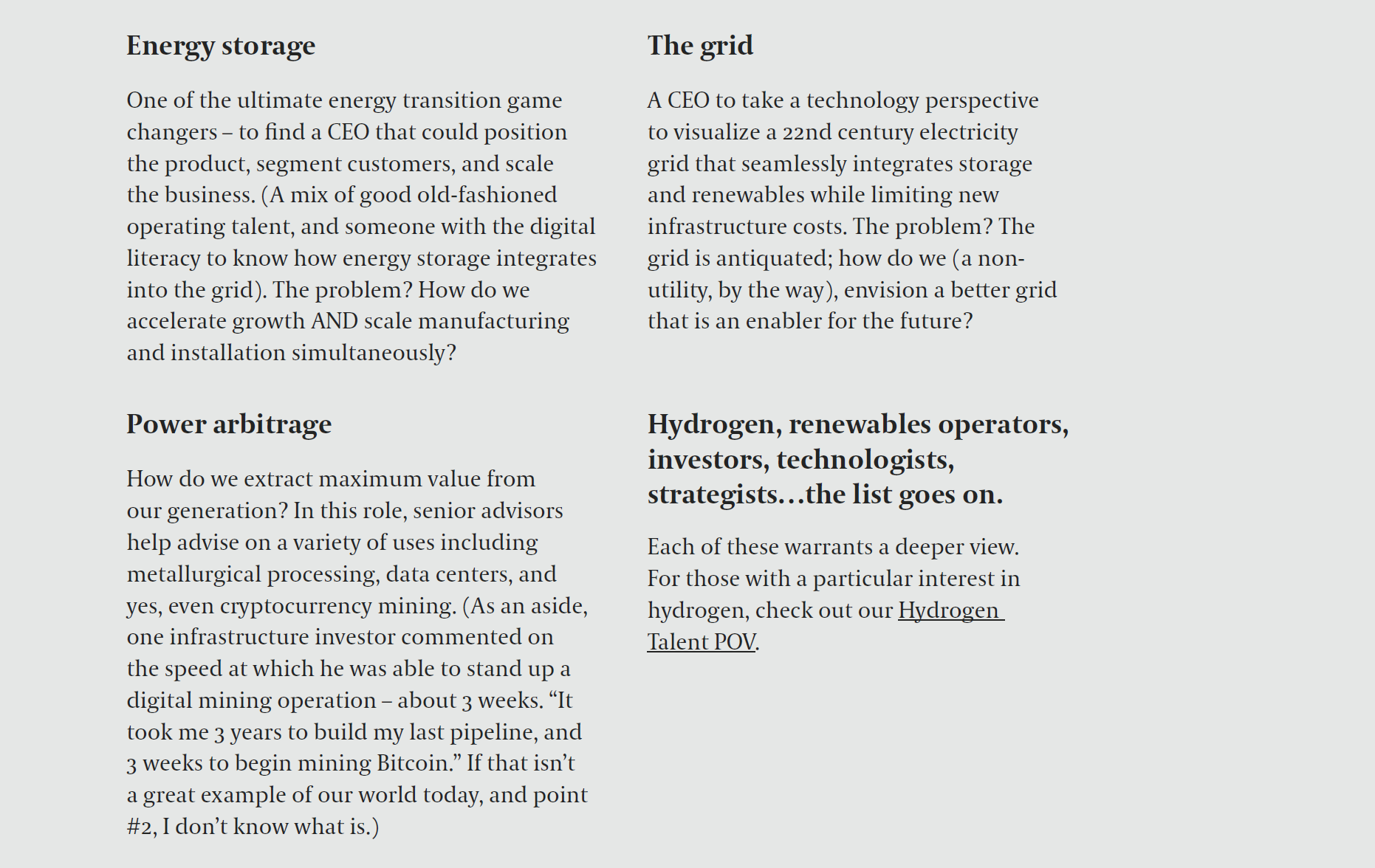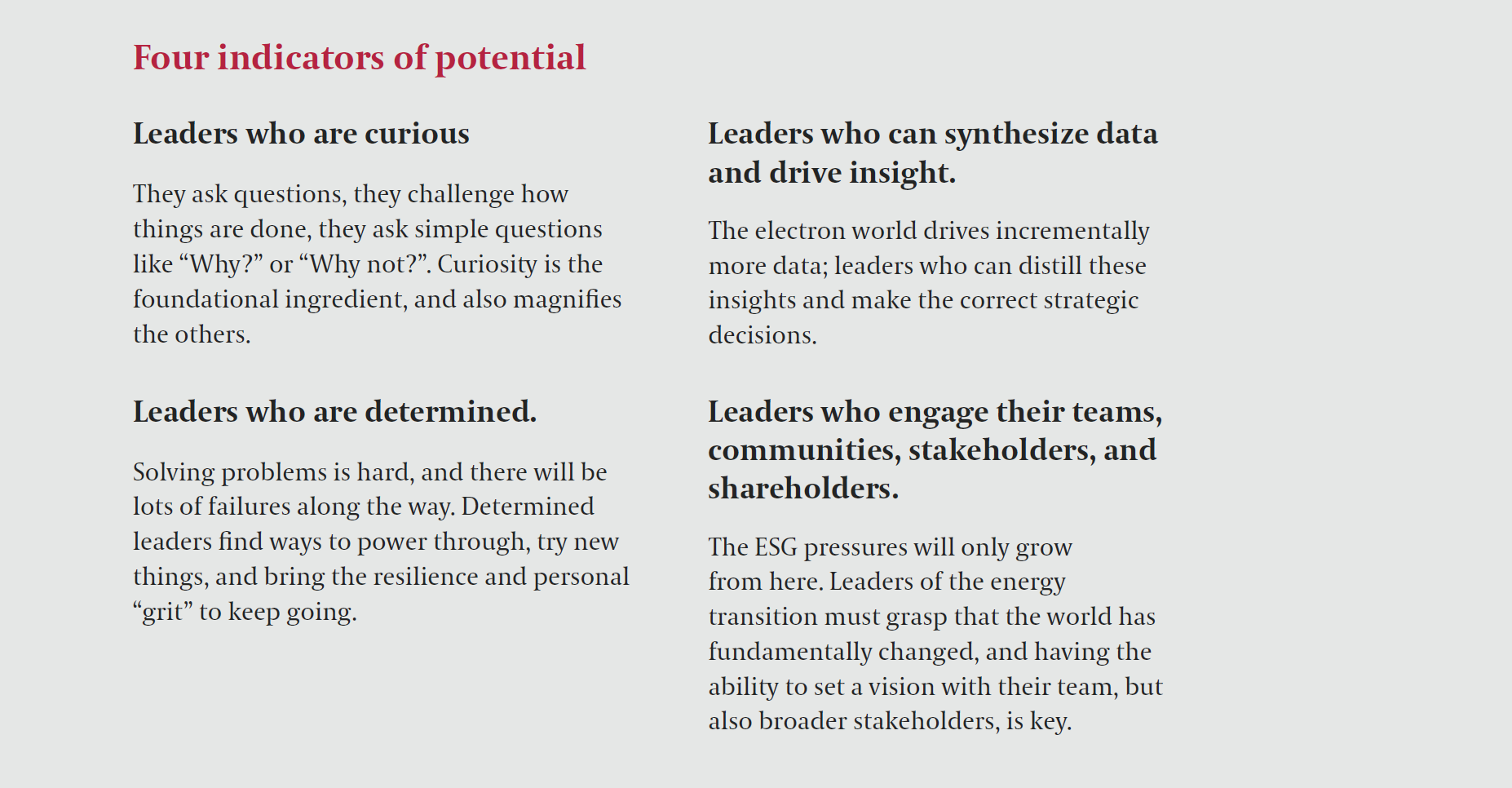It is a truism that energy is a dynamic industry. However, over the last year plus we have witnessed an extraordinary acceleration of what is being called “the energy transition.”
The reasons and implications for this acceleration are far-reaching, and covered well by the media. An equally important but less appreciated topic is the talent transition required to power the energy transition.
With an increasing number of searches and leadership advisory mandates at the intersection of talent and industry change, it is appropriate to consider people implications for organizations that are both disrupting and being disrupted. As leaders and investors prepare their leadership teams for an ever-more uncertain future, here are a few observations:
1. The transition is everywhere.
Every energy business today is by definition an energy transition business. We posit that the most important element - more critical than strategy or assets - is the human capital to harness this transition. An energy transition strategy without a talent strategy is worse than no strategy at all. Or perhaps stated differently, the world has changed fundamentally, and every energy organization must adapt both its strategy and its talent strategy.
2. From barrels, to bytes.
A key premise of the energy transition is the change from molecules to electrons, e.g. Internal combustion engines to electric vehicles; coal and gas-fired power plants to solar and wind; pipelines to transmission lines. But what are the implications?
In the molecule world, processes are physically, asset, and financially intensive. Spend time in West Texas on a drilling rig, and you know what I mean. It is hard, physical work that has skin (or more accurately, PPE!) touching steel. Hydrocarbons are physical products that require extraction, can be physically moved and stored, altered, and then distributed to the point of consumption. At varying points along this chain, ownership changes hands, often driven through commodity-based markets. Winners in the molecule economy are the best operators and risk managers who operate safely, efficiently, and within prescribed tolerances.
Conversely, in the electron world, decisions and actions happen faster. It’s digital. Electrons move at the speed of light, so speed is the killer-app. The system is in balance (until there is a winter storm in Texas, for example, or a radical battery breakthrough in the future). In this future world, digital talent with a spike in analytics and customer-facing talent will win the day. Operating skills remain important, and they are necessary but not sufficient. Re-orienting recruiting, retention, and development processes that align with the new prime functions (e.g. development, sales, technology vs. drilling, production operations, etc.) will be critical. Talent requirements must mirror the shift from moving physical barrels to the future comprised of electrons and bytes.
A corollary on this point is the convergence around energy – the soft boundaries between industries that have increasing overlap. Energy + mobility/automotive and the shift into electric vehicles, charging, and possibly autonomous transport. Energy + agriculture, and the ability to capture carbon, use less energy/fertilizer, develop new mechanisms to produce biofuels, among others. With new collaboration and competitive models emerging, flexible, nimble thinking is needed as old models shift.
3. ESG is the new ABC.
The world has changed. In the past, Environmental, Social, and Governance was often a “nice to have” when recruiting; today it is a “must have”. It is foundational, just like your ABCs. On one recent search, ESG requirements were baked into the specification from the beginning, and interviews were tailored focus on real, tangible examples of effective stakeholder management.
We led a recent project for a large private equity asset management with a successful track record in oil & gas to help build a renewables-focused team. Here, ESG factors and the fundraising implications of having an ESG-oriented team were critical.
4. Talent is in shorter supply than capital.
With new private funds being raised, public companies looking to deploy capital in new growth areas, and the prevalence of SPACs, there is no shortage of financial currency for energy transition businesses today. Others are better positioned than we are to comment on the implications here, however the point we would raise, is that given such a rapid shift, talent is today’s bottleneck. Even for more established energy transition sectors such as wind & solar, finding individuals with a 25+ year history is rare. Hydrogen, renewable natural gas, energy storage, EV charging, and other rapidly emerging sectors are even more talent-challenged, especially as many of these have seen their ups and downs in the past.
The talent challenge is particularly acute for financial investors looking to build new capabilities. (For those with more interest in this topic, and to see if my predictions from 2019 were correct, see Energy PE Investors Question the Future of Their Firms and Careers.)
Talent is in short supply, and creative approaches are needed to identify talent and ‘put the puzzle pieces together’. As one example, we have conducted an increasing number of Senior Advisor searches to help bring deep expertise that can accelerate the growth of a new network, and also serve as an alternative solution to full-time hiring.
As a final note, smart organizations are also playing defense to retain key employees. For example, we are aware of one corporate where individuals in the hydrogen organization have seen pay increases of 30-40% within the past year purely as a preventative measure.
5. Solve problems to win.
The companies that will win the energy transition will win by solving problems. Here is a recent sampling of the variety of problem solvers we have found. The challenges are complex and the opportunities are really interesting.

6. Potential is the new killer-app.
What type of talent solves the energy transition’s problems? Talent with potential. It becomes a “must have” in who you hire, and also when repurposing talent within the business to new growth or strategy areas.
So, what is potential? It has four elements. Think about a rock star in your organization, picture them. What they do, how do they act? You know it when you see it. But let me share a framework and language for how to spot it, quantify it, and assess it.

We worked with a recent client to develop a systematic approach to assessing capability and potential within their organization, evaluating their top leaders, and working a level down with a specific emphasis on spotting potential. In certain instances, new roles were selected, responsibilities re-aligned, and impactful development plans were put in place. Talent was re-oriented with less on past accomplishment, and more on how to face the future.
To conclude, as your organization looks to disrupt and/or avoid being disrupted:
- Do you know who in your organization demonstrates potential? How are you cultivating it?
- Did you plan your CEO succession for the company as it was 5 years ago, or where you will be in 5 years?
- Who are the individuals 2, or 3 levels down from the CEO, who bring the potential to not just survive the energy transition, but solve its problems?
These are some of the fundamental challenges of the energy industry today – a transition that is omnipresent, digitally oriented, and short of the most critical talent elements. New approaches and awareness are required for the energy transition’s winners to identify and unlock the human power to drive the energy transition.





